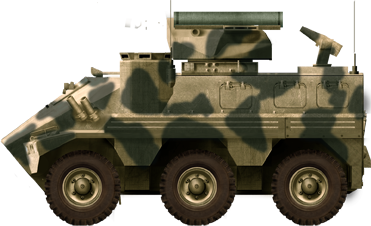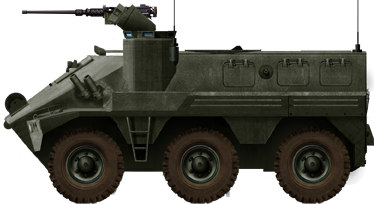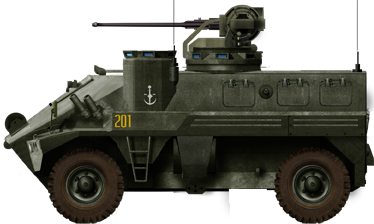A pure export product
The relative commercial success of the 1960s M3 4x4 APC conducted Panhard to enlarge his model, too cramped to be an effective carrier for a platoon or carrying heavier armaments. At the same time, Iraq, that used the M3, ordered French ATGM turrets which were too heavy for the little M3 in September 1974. Thus giving Panhard the incentive it needed to have a vehicle available in a convertible or true 4x4/6x6 configuration and already modular in its basic design approach, but so ugly that only its manufacturer/mother could love it. Whether or not aesthetics are a quality on the armored vehicles market, the VCR sold less well, being much costlier than the M3, and the French army only retained a few examples for evaluation.Development
The Panhard VCR or Véhicule de Combat à Roues, French for Wheeled Combat Vehicle, was designed by Panhard in the late 1970s to replace the M3. In reality of the two models designed, 4x4 and 6x6, the second was, in reality, a true 4x4 convertible to 6x6 because of its retractable central axle. This allowed a much better grip on rough or soft ground like sand while preserving speed on roads. The solution was not new and has been already developed by the USSR on its BRDM series and much earlier by experimental models, or by Panhard on its 1950 EBR wheeled tanks series. The prototype of the VCR was delivered in 1977 and passed all tests, leading to the set up of a production line in 1979, when it entered service with the Iraqi Army that ordered 100 vehicles.Design
Although much of the components were still shared with the M3, the Panhard VCR chassis was stretched out since the beginning to accommodate the third axle, but the vehicle was still relatively short and very compact, at 4,88 m in length versus 4,45 m. The hull was made of welded steel RHA, 12 mm at the thickest on the sloped nose, and 8 mm elsewhere, so it can resist heavy machine gun rounds on the frontal arc and small arms fire elsewhere.The driver was located in the center, and the engine, a gasoline Peugeot PRV V-6 145 hp (much powerful than the Panhard 90 hp of the M3 for 7,9 vs 6,13 tons) was located in the front-right section. The rest was dedicated to the other members of the crew, armament modules, and troops (nine infantrymen). The vehicle is amphibious and NBC protected. The crew compartment had three armored lifting hatches per side that could be used as firing ports, folding stowage bins, and two banks of two smoke grenade launchers on the nose.
The vehicle commander was on the font-left section, with a ring mount for a 7.62mm light machine gun (usually GMPG) or a 12.7 mm heavy machine gun M2HB. This section was modular enough to receive alternatively a one-man armored turret for a 7.62 mm LMG, or armored powered turret for a 20-mm autocannon, both centerline. The basic version called VCR TT (For "Transport de Troupes") was indeed designed to accommodate a large module for the ATGM launcher ordered originally by Iraq. This module has a traversable bank of four HOT wire ATGMs and 10 reloads inside the module, vertically reloaded, making it an APC/tank destroyer. It was known at the factory as VCR/TH (Tourelle HOT). A shorter range version was also offered carrying Milan ATGM in a light one-man ring mount cupola, the Panhard VCR MCT (never ordered).
Variants
-
- VCR/AT
-
- VCR/IS
-
- VCR PC
-
- VCR/TT hydrojet
Exports & active service
The most famous customer by far was Iraq, which saw these vehicles in service in the Iran-Iraq war, 1991 Gulf War and 2003 Gulf War, where most were destroyed out of the order of 100 vehicles of the tank hunter variant. There are no precise records of kills performed by these vehicles. The second middle east customer was Saudi Arabia that ordered 82 vehicles and later in 2005 donated 44 to the new Iraqi Army. Argentine (24 vehicles) was the sole customer of the "hydrojet" 4x4 variant, followed by Mexico (46 vehicles), and apparently Gabon (?unknown) or 252 exports, for a grand total of around 260 vehicles, including unsold Panhard variants and French Army evaluation vehicles.Links
The Panhard VCR on Wikipedia
Panhard VCR specifications |
|
| Dimensions (l-w-h): | 4.88 x 2.50 x 2.13 m ( 192 x 98 x 83 in) |
| Total weight, battle ready: | 7.9 Tons (15,800 ibs) |
| Crew : | 3+9 |
| Propulsion: | Peugeot gasoline PRV V-6 145 hp P/w 18.35 hp/tp |
| Suspensions: | 6x6 wheeled on leaf springs |
| Top Speed | 90 kph (56 mph) 40-70 kph off-road |
| Range (flat) | 700 km (435 mi) |
| Armament | See notes |
| Armour | Hull nose 12 mm (0.48 in), sides 8 mm (0.3 in) |
| Total Production | Around 260 |

Iraqi VCR/TH HOT tank hunter, 1991 Gulf War.

Mexican VCR TT, the basic APC version. Another version, showing a digital camouflage, is also in service.

Argentine Marines VCR TT Hydrojet amphibious APC
Mexican VCR-TT Hydrojet amphibious 4x4 variant.
Mexican VCR-TT.
Iraqi new Army, ex-SAE VCR TT

Cold War Tanks


































Cold war tanks posters

Cold War Main Battle Tanks

Cold War Soviet Army
Museums, Movies, Books & Games
The Tanks and Armor in pop culture
Tanks and armored vehicles in general are only really grasped when seen first person: The mass, the scale, it's all there. Explore also the way tanks were covered in the movie industry, in books and in video games.Movies:
Best tanks movie on warhistoryonline.com
On imdb.com
On bestsimilar.com/
miltours.com
liveabout.com/
watchmojo.com
Video Games:
pcgamesn.com
historyhit.com
levvvel.com
vg247.com/best-tank-games
mmobomb.com/
alienwarearena.com

